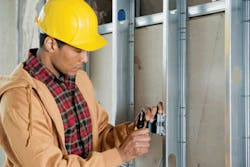Membrane Penetrations in Fire-Resistance Walls
Fire-resistance rated wall assemblies are relied upon to help provide safety to people and property from fire, combustible products, and similar hazards. In order to provide the anticipated hourly fire-resistance rating, these assemblies must be constructed and maintained in accordance with their design criteria (e.g., as shown in the UL design specifications). If the outer membrane of the wall assembly includes penetrations or recessed fixtures, these need to be protected to maintain the hourly rating.
Two types of penetrations must be considered. A through penetration has an opening that passes entirely through a fire-resistance rated assembly, while a membrane penetration has an opening that only passes through one side of the assembly. For example, a recessed electrical box mounted in a gypsum board wall surface of a fire-resistance rated wall, with conductors in the wall cavity, is a membrane penetration. This article focuses on products UL certifies for protecting membrane penetrations in these walls.
Section 712.3.2 of the 2006 International Building Code requires membrane penetrations of fire-resistance rated assemblies by recessed fixtures to be protected so that the required fire resistance is not reduced. It includes specific conditions by which electrical boxes may be installed in the wall. Exceptions to the requirements in 712.3.2 recognize conditions under which recessed steel electrical boxes on opposite sides of a wall are protected with listed putty pads or are separated by other listed materials and methods.
UL classifies putty pads and other listed materials/methods under the product category “Wall Opening Protective Materials” (CLIV or QCSN). This category covers three types of technologies: putty pads, insert pads, and gaskets. Putty pads are putty-like products installed on the outer surfaces of an electrical box prior to installation in the gypsum board membrane on the wall. Insert pads are for installation on the inside back surface of the box, while gaskets are for installation under the cover plate of the box. The latter two products may be installed after the gypsum membrane is in place. Each of these products is classified for use in specific types of fire-resistive designs when installed in accordance with the details provided in each classification. The information in each classification includes:
1) the model numbers covered,
2) the type and size of electrical box covered,
3) a description of the fire-resistance-rated wall assemblies covered,
4) the specific method for the installation of the product,
5) the type of cover plate covered, and
6) the required spacing between boxes on opposite sides of the wall.
Section 712.3.2 also permits the installation of nonmetallic electrical boxes in fire-resistance rated wall assemblies when the boxes are tested for use in fire-resistance rated walls and are installed in accordance with the instructions provided with the listing. Unlike metallic boxes, nonmetallic boxes intended for use in fire-resistance rated assemblies must be specifically listed for use in such assemblies.
UL classifies nonmetallic electrical boxes under the product category “Outlet Boxes and Fittings Classified for Fire-Resistance” (CEYY or QBWY). These nonmetallic boxes are classified for use in specific types of fire-resistive designs when installed in accordance with the details provided in each classification. The information in each classification includes:
1) the model numbers covered,
2) a description of the fire-resistance-rated wall assemblies covered,
3) the annular space between the box and the wall membrane
4) the spacing limitations for the boxes, and
5) other specific requirements or limitations of the classification.
The electrical boxes covered in this category are required to be marked with the UL symbol in a circle located in the base of the box, Class X hr, where X indicates the maximum hourly rating (i.e., 1 hr or 2 hr), and F, W, and/or C, where F = floor, W = wall, and C = ceiling.
Classifications for putty pads, insert pads, gaskets, and nonmetallic electrical boxes can be found in the UL Online Certifications Directory at www.ul.com/database/ or in the UL Fire Resistance Directory.
Walke is a staff engineer with UL. He can be reached at [email protected]. This article is reprinted with permission from Underwriters Laboratories.
